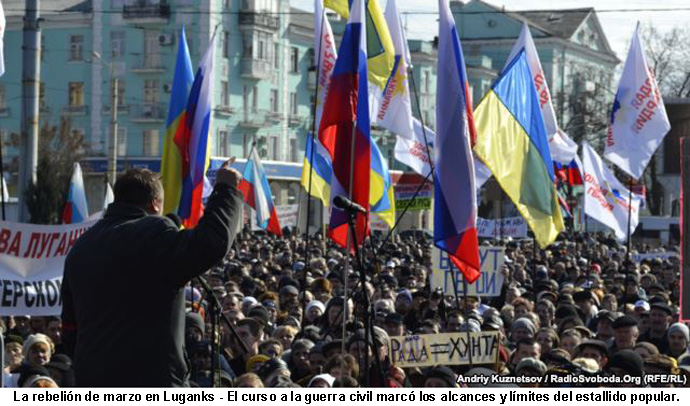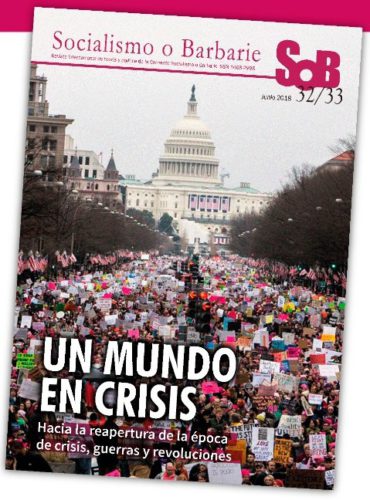
Compartir el post "Ukraine – Defeats of Kiev, negotiations with Moscow and contradictions in the situation"
Since our last article about the situation in Ukraine- “The fall of the Malaysia Airlines plane- who benefits from it?” (24/07/2014)[1] – a little over a month has passed. However, not only has a lot of water (and a lot of blood) has gone under the bridge; the situation in Ucraine has also changed.
At that time, occidental press not only dwelled over the knocked down plane but also proclaimed the victory of the good guys from Kiev over the sinister zombies from Moscow who had taken over the east of Ukraine. But the world-wise reality is not an american B movie.
They stopped talking about the Malaysia Airlines plane when the investigations pointed towards those who set its route over a warzone. That is, the controllers in Kiev.
There was also a prudent radio silence for weeks over the very course of the war. This silence was broken a few days ago, to recognize that troops in Kiev were receiving a beating and withdrawing from the front. Not by chance, simultaneously, the negotiations between Kiev and Moscow were resumed. They would have been unnecessary had the defeat of the “pro-russians” happened.
The new negotiations started in Minsk, capital city of Belarus (or Byelorussia), in a meeting between Putin with Poroshenko, the president of Kiev’s government. Since then, there is a confusing parade of affirmations and denials, over agreements and disagreements. At the closing time of this edition, it is impossible to know certainly what is really happening, although one gets the impression that a dead end has been reached… although the negotiations aren’t officially buried.
Those disagreements are numerous (and not easy to solve), because there also are- against all self-serving simplifications of the media- not just two sides but three or (possibly) four.
We have, on one side, Kiev’s government (which also obeys to different pressures, both from the USA as from other powers of the EU). Officially, Kiev still utterly defends its anti-federative and absolute centralism position which doesn’t even allows the election by popular vote of the government of Oblast (region, province).
On the other side we have Putin, who seems to seek a settlement that leaves him as a champion for Russian-speaking peoples. To that end, he proposes to stablish in Ukraine a federalism that gives more power to the Oblasts. At the same time, the Kremlin wants nothing to do with the incorporation to Russia of the “Federal State of Novorossiya (New Russia)”, built by the upraised people of the Ukrainian East. It would mean the incorporation of an upraised population, where diverse militias which can be uncontrollable have settled, including the “Shajtorskaya Diviziya” (Miner Division) formed by coal miners.
In the middle we have the upraised people from the East amongst which several positions can be found. One, the first one they defended, consisted of broad federalism, including economic and political relations with the outside. The other, which finally imposed itself, is to separate from Ukraine. From there, two possibilities open: incorporation to Russia (like Crimea) or to subsist like Novorossiya (New Russia), an independent state….formally at least.
Independence as Novorossiya seems to be the official position now. After the military triumphs of August, it was ratified in a widespread press conference by Aleksandr Zakharchenko, which seems to be an important military leader, and the chef of one of Novorossiya biggest militias, the Oplot:
“Let me clarify-said Zakharchenko-: today federalization is no longer possible. Everything has its time. We demanded federalization three months ago. Then, we asked for permission to make a referendum. That time has passed; now we want independence.”[2]
Russian nationalist directions…with undetermined outcomes
A little after the triumph of the Euro-Maidan and the overthrow of president Yanukovich, another rebellion broke in the East of Ukraine. These two rebellions, which aroused on the background of a historic regional division between Eastern and Western Ukraine, had from the beginning different characteristics.
The rebellion of the Euro-Maidan, centered in Kiev and the oblast of Western Ukraine, had mainly middle class sectors, employed people, students, etc. as protagonists. And, above all, it also had political leaderships which oriented and strongly controlled it: two great electoral bourgeois parties (Batkivschina and Udar) and two strong extreme right wing groups which brought the militancy (the fascists of Svoboda and the neo-Nazis of the Pravy Sektor).
The later rebellion of the East, on the contrary, not only had much more socially plebeian actors, of the working class; initially, it lacked political directions as strong as those which controlled the Euro-Maidan. Of course, as we pointed out at the time, those “voids” can’t last long. Unavoidably, someone occupies them. Those who mainly filled that void were the organizations (and mini-organizations) of Russian nationalism (and ultra-nationalism)[3], which already existed on both sides of the frontier, and which were also strengthened by an affluence of volunteers coming from Russia and other countries. Since then public figures and leaders have gone up and down, because of both internal struggles and of pressure from Moscow…
Western propaganda outlines the caricature of a “Russian military invasion”, among other reasons to justify the defeats suffered by the troops of Kiev. The truth is different and more complex. As the Ukrainian sociologist V. Ishchenko points out, “…the government propaganda (of Kiev) insists that the whole movement (of the East) is led by Russia, but that is wrong. Of course, amongst the Russians who have come to volunteer there must be agents of the (Russian) state. But most of them are just that, volunteers…”[4]
However, without being mere agents at Putin’s orders, Moscow has strong means to pressure them; for example, sending humanitarian help (like the recent truck caravans) and probably light weapons and ammo… although everything seems to suggest a severe rationing exists.
But, at the same time, the pan-Russian nationalists who have taken the lead, have means to pressure Putin as well. Facing Russia’s public opinion, Putin can’t just turn his back on them.
Of course, our defense of the right of self-determination of the people of the East of Ukraine can’t include any support or political trust in these nationalist leaderships, even if they defend the “French Revolution”. We must not confuse one thing with another. That is to say, neither believe that those leaderships are progressive because they defend a right cause (like some left wing organizations do), nor discredit that cause because of their actual political direction either (like other organizations do).
This takes us to the big issue: how those contradictions will evolve. That is to say, the possibilities of independent and class leaderships which are forged in this fight, and retake the extraordinary socialist revolutionary traditions of workers in Eastern Ukraine. That seems far away, but needs and class contradictions strike.
In this sense, the Russian sociologist Boris Kagarlitsky highlights “a growing political radicalization inside the movement. In August, an open letter from the grassroots fighters in the militias was published, demanding that the slogan of “social republics” with which the republics of Donetsk and Lugansk were proclaimed becomes a reality. To that end, they demand that oligarchs’ properties be nationalized and that measures be taken in favor of workers. The post of president of the Supreme Soviet was taken by Boris Litvinov, a communist militant that broke ties with the official direction of his party. He dictated a law annulling the privatization of public health, with timid attempts to nationalize it…”[5]
At the same time, Kagarlitsky relays the immediate reaction, in the contrary sense, of Moscow. Their answer ranged from pressuring to dismiss the leaders that gave in or rode on those “radical” tendencies, to making a deal with the Ukrainian oligarch Rinat Akhmetov for him to act as a mediator in the negotiations with Kiev.
Of course, those and other elements of radicalization that Kagarlitsky pints out don’t imply the constitution of an independent political alternative. But they do show that the process isn’t frozen up nor the pressures of Moscow have managed to quiet the voices of those who demand radical measures.
An especially sensitive point could be that of “private property”. The East is the industrial region of Ukraine. The oligarchs, be they from the East or the West, have aligned with Kiev, practically with no exceptions. Why shouldn’t their properties be nationalized? What will be done with their enterprises? Privatize them back? Hand them over to Russia? Or nationalize them so that their workers put them to work again, under their control?
_____________________________________________
[1] Socialism o Barbarism Nº 297
[2] Press conference video of Zakharchenko: https://www.youtube.com/watch?v=6ju29v1fh9c
[3] In the interview we mentioned, to shake off the accusation of being “Russian fascists” (symmetrical to the Ukrainian fascists of Svoboda and the Pravy Sektor), Zakharchenko swears that his principles are those of the French Revolution, “freedom, equality, fraternity”, etc, etc.
[4] Volodymyr Ishchenko, “Ukraine’s Fractures”, New Left Review Nº 87, May/June 2014.
[5] Boris Kagarlitsky “Eastern Ukraine people’s republics between militias and oligarchs”, Links, 18/08/2014, our underlining.
By Claudio Testa, Socialism or Barbarism Nº 303, 04/09/2014


